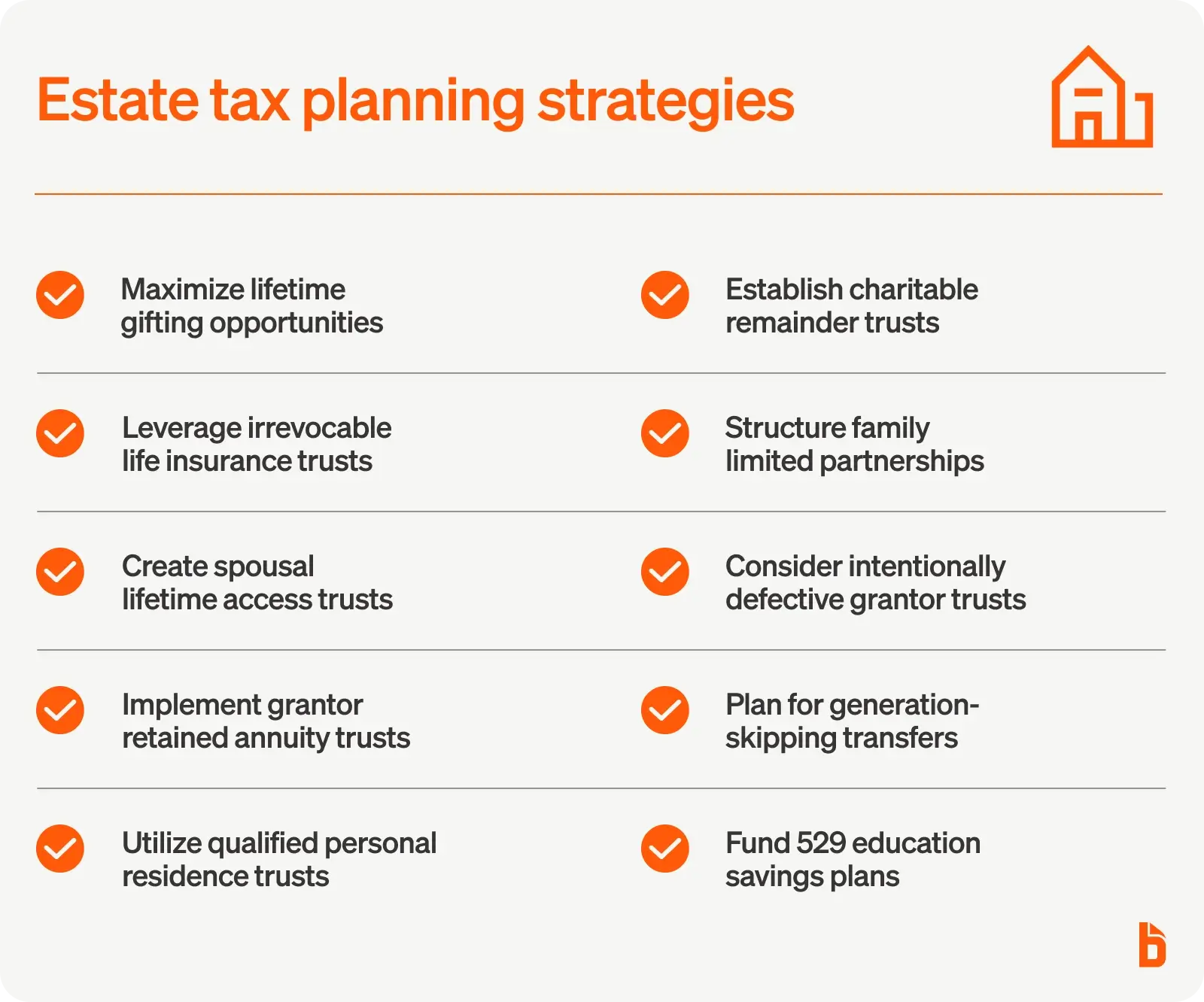For high-net-worth clients, effective estate tax planning can mean the difference between preserving generational wealth and potentially losing millions to taxes. With the current estate tax exemption set to drop by roughly half after 2025, now is the time to implement strategies that protect and transfer wealth efficiently.
Whether you're helping clients navigate the complexities of multi-million-dollar estates or planning for the upcoming sunset provisions, the right approach can save substantial taxes while achieving your clients' legacy goals.
Communicating the four types of estate planning taxes to your clients
Understanding the tax landscape is fundamental to effective estate planning. High-net-worth individuals must consider four distinct types of taxes:
Income tax continues to apply to earnings from estate assets, and beneficiaries may owe income tax on certain types of inherited assets like traditional IRAs.
Gift tax applies to transfers made during your lifetime that exceed annual exclusion amounts.
Estate tax is assessed on the total value of assets transferred at death.
Generation-skipping transfer tax adds an additional 40% tax on transfers to grandchildren or others more than one generation below the transferor.
Each plays a different role in the overall tax picture, and estate planning strategies that minimize one may impact another. Are you leveraging all 9 of these estate tax strategies to maximize your clients' wealth?

Strategy 1: Maximize lifetime gifting opportunities
The simplest way to reduce estate tax liability is by giving away assets while still alive, removing them from the taxable estate. In 2025, individuals can give up to $19,000 per person annually without filing a gift tax return, and married couples can double this to $38,000 per recipient.
Beyond annual gift tax exclusions, the lifetime gift and estate tax exemption offers substantial planning opportunities. With the exemption at $13.99 million in 2025 but scheduled to drop after the sunset provision, wealthy families should consider making large gifts now to lock in the higher exemption. These gifts can be made outright or through trusts that provide ongoing control and protection.
Strategic gifting becomes even more powerful when combined with valuation discounts for business interests or when gifting assets are expected to appreciate significantly. By transferring these assets now, all future growth occurs outside the taxable estate.
Strategy 2: Leverage irrevocable life insurance trusts (ILITs)
Life insurance proceeds are included in your estate for tax purposes, potentially pushing estates over the exemption threshold. An ILIT removes life insurance from the taxable estate while providing liquidity to pay estate taxes or support beneficiaries.
The trust owns the life insurance policy, not the individual, keeping the death benefit outside the estate. When structured properly inside an ILIT, life insurance can provide needed liquidity without raising estate taxes. This strategy is particularly valuable for estates with illiquid assets like real estate or business interests.
Beneficiaries receive the insurance proceeds free from both income and estate taxes, making ILITs one of the most efficient wealth transfer tools available.
Strategy 3: Create spousal lifetime access trusts (SLATs)
A SLAT allows one spouse to make a gift to a trust for the benefit of the other spouse and descendants, using their lifetime exemption while maintaining indirect access to the assets. This strategy has gained popularity as families rush to use their exemptions before the 2026 sunset.
Each spouse can fund a SLAT for the other, effectively doubling the strategy's impact while maintaining access to trust assets through distributions to the beneficiary spouse. The key is ensuring the trusts aren't identical to avoid the reciprocal trust doctrine.
SLATs offer flexibility for couples concerned about giving away too much while still achieving significant estate tax savings. They're particularly valuable when there's uncertainty about future financial needs.
Strategy 4: Implement grantor retained annuity trusts (GRATs)
GRATs allow you to transfer asset appreciation to heirs with minimal gift tax consequences, making them especially attractive in low interest rate environments. The grantor transfers assets to the trust and receives annuity payments over the trust term.
If assets grow faster than the IRS assumed interest rate, the excess growth passes to beneficiaries tax-free. Mark Zuckerberg famously used GRATs to transfer over $37 million to heirs without gift or estate taxes when Facebook went public.
Short-term rolling GRATs can capture volatility in asset values, while longer-term GRATs work well for assets with steady appreciation potential. The strategy requires no gift tax exemption if structured properly.
Strategy 5: Utilize qualified personal residence trusts (QPRTs)
QPRTs allow you to transfer your residence to heirs at a reduced tax cost while continuing to live there for a specified term. The gift value is discounted based on your retained right to occupy the property.
This strategy works particularly well when interest rates are higher, as the discount increases. If you survive the trust term, the residence passes to beneficiaries outside your estate. Many high-net-worth families use QPRTs as part of their estate plan to reduce their taxable estate while maintaining use of valuable real estate.
The main risk is that if you don't survive the trust term, the property returns to your estate. Careful consideration of the term length and your life expectancy is essential.
Strategy 6: Establish charitable remainder trusts (CRTs)
CRTs provide income to you or your family for a specified term, with the remainder passing to charity, offering both income tax deductions and estate tax benefits. In high interest rate environments, CRTs can provide larger charitable contribution deductions and higher annual payouts.
These trusts work especially well for highly appreciated assets. By contributing the assets to a CRT, you avoid immediate capital gains tax while receiving an income stream. The charitable income tax deduction can offset current income taxes.
Charitable giving reduces your taxable estate dollar-for-dollar, making it one of the most straightforward ways to reduce estate taxes.
Strategy 7: Structure family limited partnerships (FLPs)
FLPs can reduce estate and gift taxes through valuation discounts when transferring interests to family members. By holding assets like family businesses or real estate in an FLP, you can gift limited partnership interests at discounted values.
Valuation discounts reflect the fact that minority interests in family entities have reduced marketability and control, potentially reducing transfer values by 20-40%. This leverage allows you to transfer more wealth using less exemption.
FLPs also provide asset protection benefits and centralized management for family assets. However, they require careful structuring and ongoing administration to withstand IRS scrutiny.
Strategy 8: Consider intentionally defective grantor trusts (IDGTs)
IDGTs allow you to remove assets from your estate while continuing to pay income taxes on trust income, effectively making tax-free gifts to beneficiaries. This "tax burn" strategy lets the trust assets grow without being reduced by income taxes.
You can also sell assets to an IDGT in exchange for a promissory note, freezing the asset value in your estate. If assets grow faster than the note's interest rate, excess growth passes to the next generation free of estate tax.
IDGTs offer flexibility through the grantor's ability to turn off grantor trust status or substitute assets. They work particularly well for assets expected to appreciate significantly.
Strategy 9: Plan for generation-skipping transfers
The GST tax applies at 40% on transfers to grandchildren or others two or more generations below you, in addition to regular estate or gift taxes. Without planning, transfers to grandchildren could face combined taxes up to 80%.
Each person has a GST exemption equal to the estate tax exemption ($13.99 million in 2025), but unlike the estate tax exemption, unused GST exemption isn't portable between spouses. This makes it critical to use both spouses' GST exemptions through proper planning.
Dynasty trusts can leverage GST exemptions to create multi-generational wealth that avoids estate taxes at each generation. Careful allocation of GST exemption to the right assets and trusts maximizes this powerful planning tool.
Strategy 10: Fund 529 education savings plans
529 plans allow tax-advantaged educational savings with the ability to superfund up to five years of annual exclusion gifts at once—up to $95,000 per beneficiary ($190,000 for married couples) in 2025.
These contributions immediately leave your estate while maintaining some control through your ability to change beneficiaries or reclaim funds if needed. The tax-free growth and distributions for education expenses provide additional benefits.
For families with multiple children or grandchildren, 529 plans offer a simple way to reduce estate taxes while providing for education. They're particularly useful for grandparents wanting to support education without triggering GST tax.
FAQs for estate tax planning strategies
Understanding the nuances of estate planning can help advisors better serve their high-net-worth clients. Here are answers to common questions that arise during the planning process.
What is the 5 by 5 rule in estate planning?
The 5 by 5 rule allows trust beneficiaries to withdraw the greater of $5,000 or 5% of the trust's total value each year without the trust assets being included in their taxable estate. This provision provides flexibility for beneficiaries who may need access to funds while preserving the trust's tax advantages.
The rule helps avoid giving beneficiaries a general power of appointment over trust assets, which would cause inclusion in their estates. However, small trusts could be depleted quickly if beneficiaries consistently withdraw the maximum amount.
Do beneficiaries pay taxes on estate distributions?
Generally, beneficiaries don't owe income tax on inherited assets, as inheritances aren't considered taxable income under federal law. Inherited property also receives a stepped-up basis to fair market value at death, potentially eliminating capital gains on appreciation during the deceased's lifetime.
However, there are important exceptions to understand. Beneficiaries must pay income tax on distributions from inherited traditional IRAs and on income in respect of a decedent (IRD), such as final paychecks or deferred compensation. Five states—Kentucky, Maryland, Nebraska, New Jersey, and Pennsylvania—also impose inheritance taxes on beneficiaries, with rates varying based on the relationship to the deceased.
How BILL helps wealth managers demonstrate value to high-net-worth clients
Successful estate planning requires more than just tax strategies—it demands operational excellence that builds client confidence. BILL's solutions for wealth management services help advisors deliver the sophisticated financial management that high-net-worth clients expect.
By automating routine financial tasks and providing real-time visibility across complex multi-entity structures, BILL enables wealth managers to focus on strategic planning rather than administrative work. The platform's robust controls and detailed audit trails demonstrate the professionalism that strengthens client relationships.
When advisors can efficiently manage financial operations while maintaining security and transparency, they create more time for the high-value estate planning conversations that truly make a difference for wealthy families.







